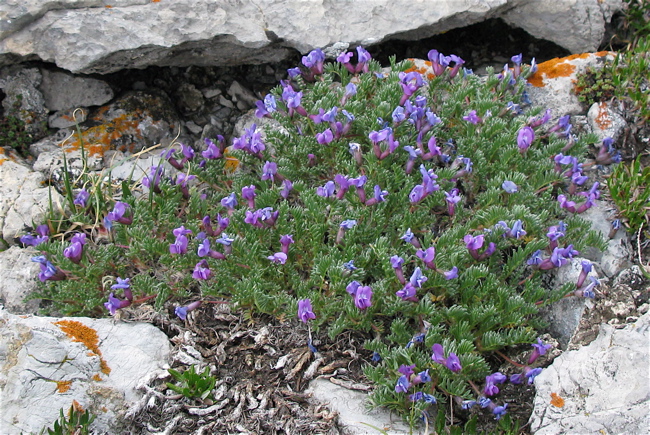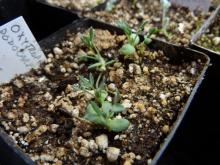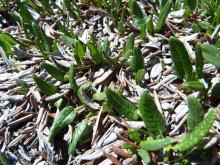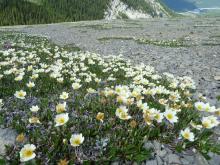Hmm, I suppose that that common name, "inflated oxytrope", like bladderpod, is not likely to hold much appeal for the gardening public! Oh well.
Oxytropis podocarpa is probably one of the most distinctive alpine oxytropis in this area, due to its very finely divided leaves and for its colourful seed pods. Its purple flowers fade attractively to blue. It is quite common and can blanket fairly large areas, in suitable habitat - that being "exposed rocky ridges and turfy alpine hillsides" (Moss & Packer, Flora of Alberta).


Comments
Mark McDonough
Re: Inflated oxytrope
Sun, 02/21/2010 - 5:00pmThat's a very fine species... love the inflated seed pods on some Oxytropis & Astragalus species (like A. ceramicus), and certainly the inflated red pods on O. podocarpa are as attractive as the fine foliage and flowers. In the first photo, the environment looks so hot and austere that one wonders if it can be easily cultivated. What is your cultivation experience with this species?
I think we should follow Panayoti's lead, drumming up novel and preferred "common names" to those with less-than-complementary common names. I like the well known "locoweed" name, which applies equally to both genera, although the "weed" part imparts a negative connotation. How about "LocoPods" or "ToxiPods"?
Lori S. (not verified)
Re: Inflated oxytrope
Sun, 02/21/2010 - 5:16pmThe dry, bleached-looking rock does make it look hot and austere but, actually, this is not a hot area... The highest temp we've experienced at elevation here was an unusually warm 26 deg C, 79 deg F - almost chilly by the standards of many areas. ;D Unfortunately, I don't have any experience at growing it. I have just started some seeds, though, so maybe I can comment on its cultivation some day.
;D
Panayoti Kelaidis
Re: Inflated oxytrope
Fri, 06/04/2010 - 7:22pmYour Oxytropis picture could have been taken on the Mosquito Mountains of Colorado: it looks identical.
We find it challenging to grow in Denver: too hot and dry here..
Lori S. (not verified)
Re: Inflated oxytrope
Sat, 02/26/2011 - 9:43amTrue leaves starting to develop on seedlings:

cohan (not verified)
Re: Oxytropis podocarpa, Inflated oxytrope
Wed, 01/11/2012 - 1:04amThe only place I've personally seen this species- near the foot of the Athabasca Glacier- Columbia Icefield is certainly not hot-- although I've not been there in all summer months, I'd have to dig through old files to check- its never even been at all warm when I was there, usually with an icey wind (it is below a glacier!).. nor would I expect it to be dry- though maybe it could be for a short time in July? Some of the plants I saw were in low places between piles of glacial rubble and at blooming time would not likely have been free of snow for very long... some growing alone (more exposed spots) or with a couple different Dryas spp, as well as Hedysarum and/or some other larger pea species..
More of them here:
http://nargs.org/smf/index.php?topic=591.75
and my full album of the site here:
https://picasaweb.google.com/cactuscactus/AlbertaRockyMountainsMay312011...
Richard T. Rodich
Re: Oxytropis podocarpa, Inflated oxytrope
Wed, 01/11/2012 - 5:58pmNot to downgrade the beautiful flowers and foliage of Oxytropis podocarpa in your photos, Cohan, but the Dryas also caught my eye.
I had assumed the genus was evergreen, but obvious, not always (?)
Lori S. (not verified)
Re: Oxytropis podocarpa, Inflated oxytrope
Wed, 01/11/2012 - 6:37pmOxytropis podocarpa can grow in great abundance in dry areas, though it's not limited to those, as you point out. In higher snowfall areas, I only see it on rocky exposures (and generally not in any great number), not in the wet meadows (which I'm sure is not surprising).
Rick, I would imagine in mild climates that Dryas may well be completely evergreen but in areas with severe winters (here, I mean ;)), the mats tend to have a lot of old dry leaves at the base and it seems to be the newer growth that is evergreen. As the season progresses, I think more new growth hides the old mat. Here's a photo of Dryas integrifolia, that has just emerged out of the melting snow - I suppose a lot of this may be quite new foliage, but you can see some damaged, likely older leaves also:

Same on this one... which I think is also D. integrifolia (or maybe a D. octopetala/D. integrifolia hybrid?):

Richard T. Rodich
Re: Oxytropis podocarpa, Inflated oxytrope
Wed, 01/11/2012 - 7:23pmLori, I would have expected that all of the green leaves in those two photos of yours are new growth. My Dryas ocotopetala grows in non-alpine garden soil, and its leaves are evergreen through the first winter only, dying off as summer progresses. I assumed that if it grew in more amenable conditions, the leaves would be more evergreen. There I go again: my best efforts at generalization down the drain.
Lori S. (not verified)
Re: Oxytropis podocarpa, Inflated oxytrope
Wed, 01/11/2012 - 7:26pmKeep in mind that I'm kind of guessing about this!
But the leaves of your plant die off during the summer? That's completely unexpected to me.
Richard T. Rodich
Re: Oxytropis podocarpa, Inflated oxytrope
Wed, 01/11/2012 - 9:24pmI mean only the leaves from the year before die off during the summer. New leaves of the same growing season remain throughout that growing season and through the first winter.
Trond Hoy
Re: Oxytropis podocarpa, Inflated oxytrope
Thu, 01/12/2012 - 8:06amMy Dryas octopetala stays green all winter if it is not to much frost. However, the leaves don't get older than one year anyway and dies during summer when the new growth "take off". Almost all the leaves of the plant I have at my mountain cabin die during winter but the plant sits very exposed.
cohan (not verified)
Re: Oxytropis podocarpa, Inflated oxytrope
Thu, 01/12/2012 - 4:55pmI suppose at some point, wetter meadows would also give too much competition for O podocarpa? Just rank speculation...
We may need to have the Dryas sub-thread excised soon...lol.. Rick- I haven't seen the same plants at enough different seasons to comment on their cycle, (I have D drummondii growing here, but it really just took off in the last year or so, so no matting yet) but will say that the large colonies of them in this and other sites, at this early time in the year were decidedly crunchy, and while I did not look at them with an eye to checking age of leaves, I don't think all the leaves present could be new at this time of year, probably the previous year's growth.. As Lori points out, they don't all look fresh enough, and I think its just too early at this site..
A couple more shots, the first I assume is Dryas drummondii, the other is a mixed mat with deciduous Arctosatphylos rubra (the lovely bright green over to the right) just emerging and another semi-evergreen, A uva-ursi with some brown leaves at upper left, with presumably D drummondii to the right and probably D octopetala (it seems likely that drummondii, octopetala and integrifolia all occur at this site, but I'm even less sure of them than Lori ;) There are definitely too many leaves on them to be all new at this early date..
cohan (not verified)
Re: Oxytropis podocarpa, Inflated oxytrope
Thu, 01/12/2012 - 4:57pmBTW- I hadn't thought about it before, but I guess summer leaf die off is reasonable enough- that's how our other local evergreens do it-- Pyrolas et al..
Lori S. (not verified)
Re: Oxytropis podocarpa, Inflated oxytrope
Thu, 01/12/2012 - 6:35pmVery interesting. I only grow D. octopetala and haven't noticed any leaf die-off during the summer, but I'll try to remember to pay attention this summer. Haven't noticed it in the wild either, but the season is so short anyway that perhaps it occurs more during the winter.
I'd tend to think it's more that it requires drainage... I don't see any of the peas growing in the wet alpine meadows.
cohan (not verified)
Re: Oxytropis podocarpa, Inflated oxytrope
Fri, 01/13/2012 - 11:42pmCould well be.. I have not tended to think of any part of the Columbia Icefield ('tourist' area near the foot of the Athabasca Glacier) as being dry, never seems to be far from snowing there.. but I don't think I've ever been in mid-summer, need to check back in the files and see.. and of course I also did not actually check soil moisture, so at times I might have been confusing cold (always) with moist!